MGNT341: International and Comparative HRM Report on Japanese MNEs
VerifiedAdded on 2022/11/23
|13
|3997
|320
Report
AI Summary
This report provides a comprehensive analysis of the International Human Resource Management (IHRM) practices of Japanese Multinational Enterprises (MNEs). It begins by defining IHRM and comparative HRM, then delves into the distinctive national business system of Japan, highlighting its unique features such as employer loyalty, consensus decision-making, and long-term goals. The report explores the specific HRM policies and practices of Japanese MNEs, including recruitment and selection processes, which often involve high-cost practices and thorough evaluations, as well as remuneration strategies that aim to retain employees through competitive compensation packages. Training and development are also discussed, emphasizing the importance of continuous learning and career advancement. The report covers key HR functions such as recruitment and selection, remuneration, and training and development. Finally, the report offers recommendations to address gaps in IHRM and concludes by summarizing the main findings and suggesting areas for future research. The report draws on academic journal articles to support its analysis and meet the requirements of the assignment.

International and comparative human resource management
Paraphrase This Document
Need a fresh take? Get an instant paraphrase of this document with our AI Paraphraser
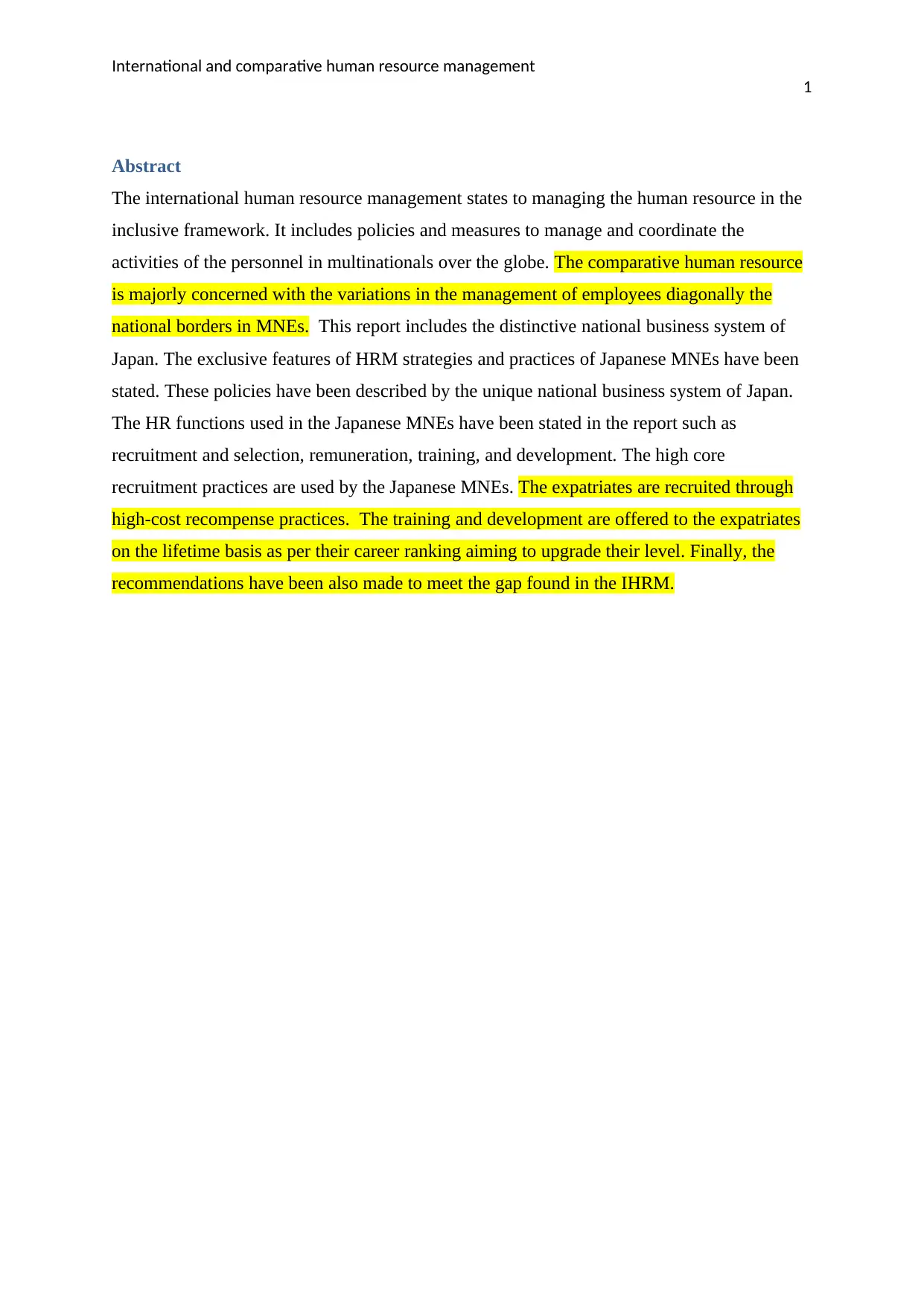
International and comparative human resource management
1
Abstract
The international human resource management states to managing the human resource in the
inclusive framework. It includes policies and measures to manage and coordinate the
activities of the personnel in multinationals over the globe. The comparative human resource
is majorly concerned with the variations in the management of employees diagonally the
national borders in MNEs. This report includes the distinctive national business system of
Japan. The exclusive features of HRM strategies and practices of Japanese MNEs have been
stated. These policies have been described by the unique national business system of Japan.
The HR functions used in the Japanese MNEs have been stated in the report such as
recruitment and selection, remuneration, training, and development. The high core
recruitment practices are used by the Japanese MNEs. The expatriates are recruited through
high-cost recompense practices. The training and development are offered to the expatriates
on the lifetime basis as per their career ranking aiming to upgrade their level. Finally, the
recommendations have been also made to meet the gap found in the IHRM.
1
Abstract
The international human resource management states to managing the human resource in the
inclusive framework. It includes policies and measures to manage and coordinate the
activities of the personnel in multinationals over the globe. The comparative human resource
is majorly concerned with the variations in the management of employees diagonally the
national borders in MNEs. This report includes the distinctive national business system of
Japan. The exclusive features of HRM strategies and practices of Japanese MNEs have been
stated. These policies have been described by the unique national business system of Japan.
The HR functions used in the Japanese MNEs have been stated in the report such as
recruitment and selection, remuneration, training, and development. The high core
recruitment practices are used by the Japanese MNEs. The expatriates are recruited through
high-cost recompense practices. The training and development are offered to the expatriates
on the lifetime basis as per their career ranking aiming to upgrade their level. Finally, the
recommendations have been also made to meet the gap found in the IHRM.
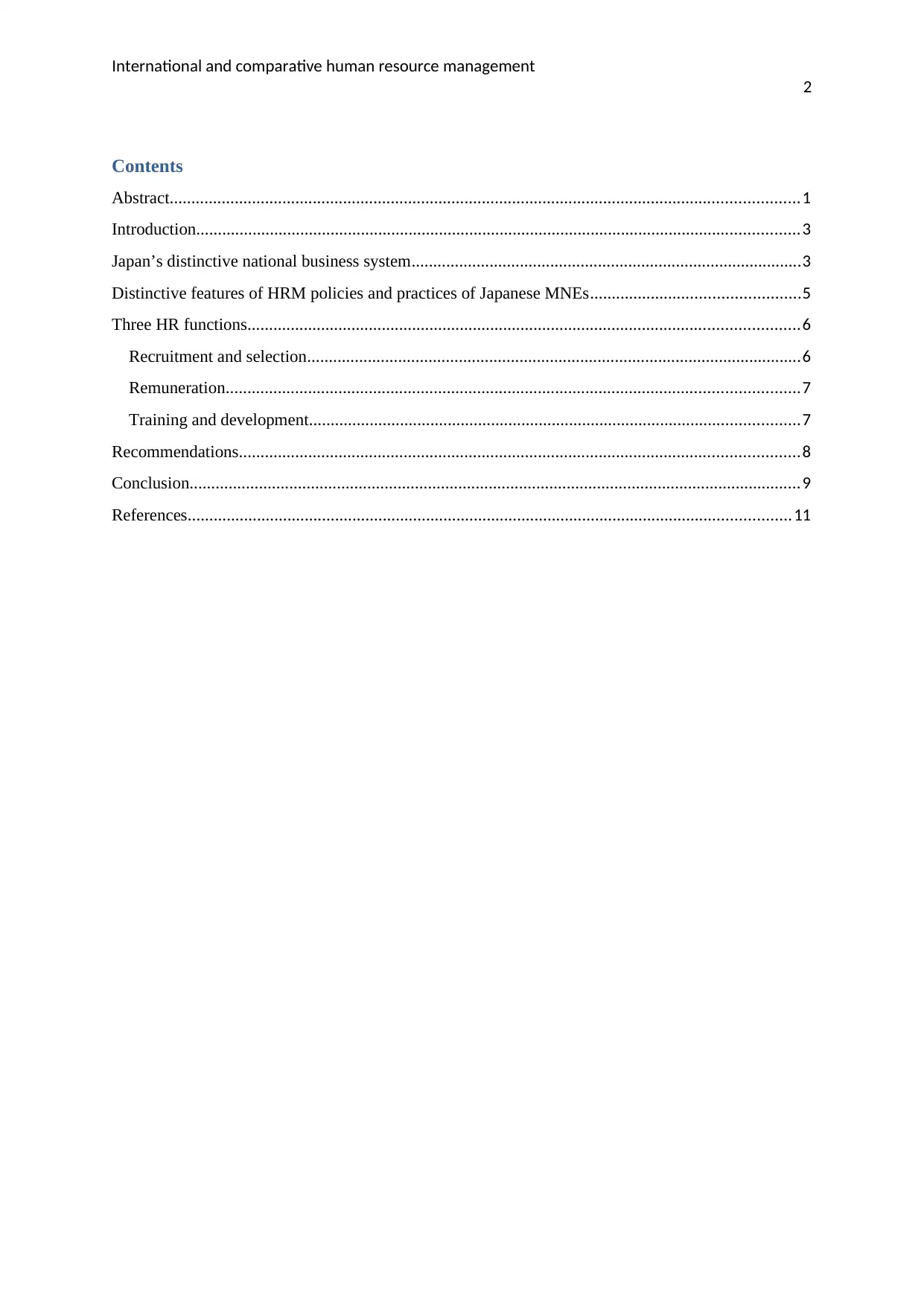
International and comparative human resource management
2
Contents
Abstract.................................................................................................................................................1
Introduction...........................................................................................................................................3
Japan’s distinctive national business system..........................................................................................3
Distinctive features of HRM policies and practices of Japanese MNEs................................................5
Three HR functions...............................................................................................................................6
Recruitment and selection..................................................................................................................6
Remuneration....................................................................................................................................7
Training and development.................................................................................................................7
Recommendations.................................................................................................................................8
Conclusion.............................................................................................................................................9
References...........................................................................................................................................11
2
Contents
Abstract.................................................................................................................................................1
Introduction...........................................................................................................................................3
Japan’s distinctive national business system..........................................................................................3
Distinctive features of HRM policies and practices of Japanese MNEs................................................5
Three HR functions...............................................................................................................................6
Recruitment and selection..................................................................................................................6
Remuneration....................................................................................................................................7
Training and development.................................................................................................................7
Recommendations.................................................................................................................................8
Conclusion.............................................................................................................................................9
References...........................................................................................................................................11
⊘ This is a preview!⊘
Do you want full access?
Subscribe today to unlock all pages.

Trusted by 1+ million students worldwide
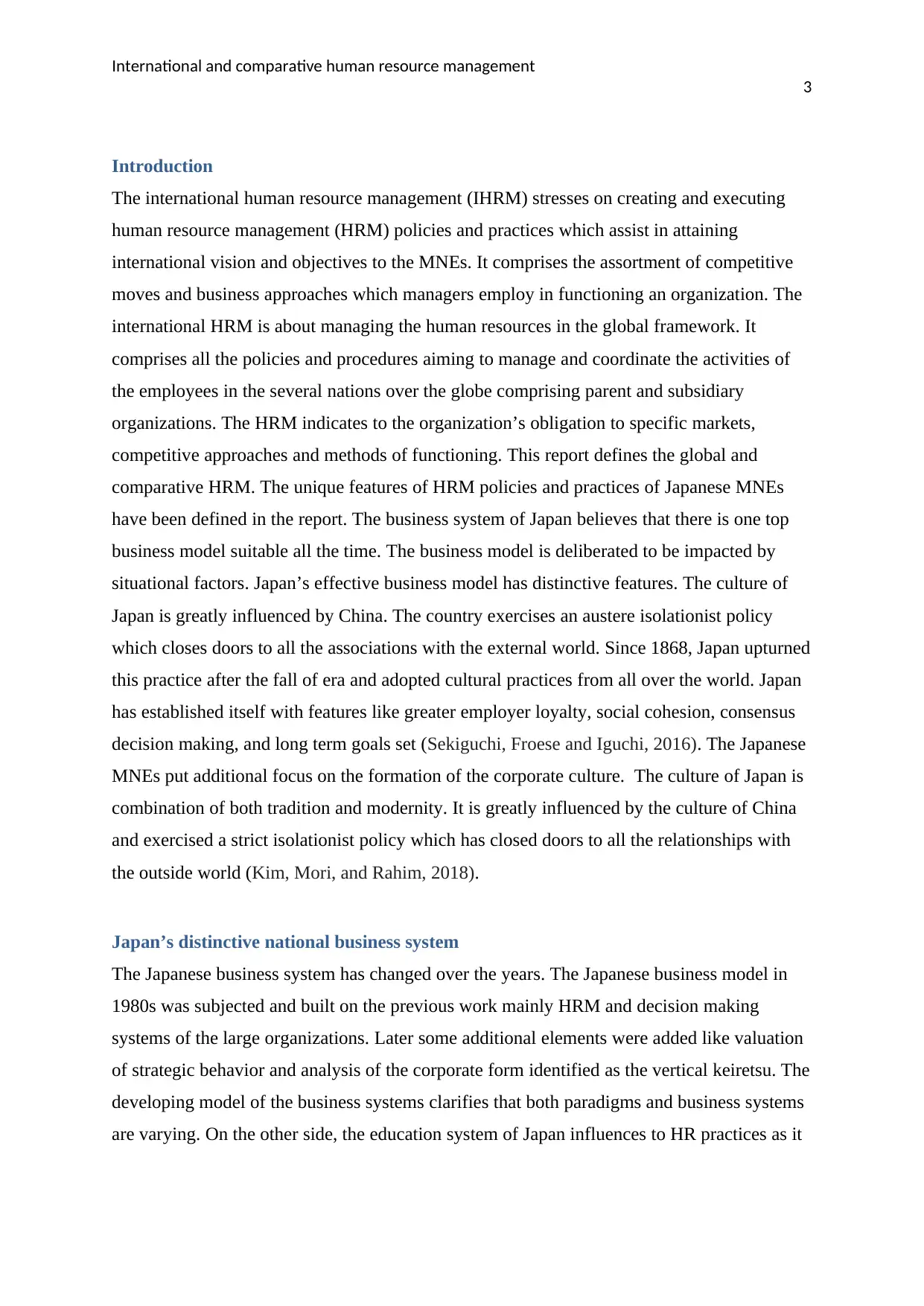
International and comparative human resource management
3
Introduction
The international human resource management (IHRM) stresses on creating and executing
human resource management (HRM) policies and practices which assist in attaining
international vision and objectives to the MNEs. It comprises the assortment of competitive
moves and business approaches which managers employ in functioning an organization. The
international HRM is about managing the human resources in the global framework. It
comprises all the policies and procedures aiming to manage and coordinate the activities of
the employees in the several nations over the globe comprising parent and subsidiary
organizations. The HRM indicates to the organization’s obligation to specific markets,
competitive approaches and methods of functioning. This report defines the global and
comparative HRM. The unique features of HRM policies and practices of Japanese MNEs
have been defined in the report. The business system of Japan believes that there is one top
business model suitable all the time. The business model is deliberated to be impacted by
situational factors. Japan’s effective business model has distinctive features. The culture of
Japan is greatly influenced by China. The country exercises an austere isolationist policy
which closes doors to all the associations with the external world. Since 1868, Japan upturned
this practice after the fall of era and adopted cultural practices from all over the world. Japan
has established itself with features like greater employer loyalty, social cohesion, consensus
decision making, and long term goals set (Sekiguchi, Froese and Iguchi, 2016). The Japanese
MNEs put additional focus on the formation of the corporate culture. The culture of Japan is
combination of both tradition and modernity. It is greatly influenced by the culture of China
and exercised a strict isolationist policy which has closed doors to all the relationships with
the outside world (Kim, Mori, and Rahim, 2018).
Japan’s distinctive national business system
The Japanese business system has changed over the years. The Japanese business model in
1980s was subjected and built on the previous work mainly HRM and decision making
systems of the large organizations. Later some additional elements were added like valuation
of strategic behavior and analysis of the corporate form identified as the vertical keiretsu. The
developing model of the business systems clarifies that both paradigms and business systems
are varying. On the other side, the education system of Japan influences to HR practices as it
3
Introduction
The international human resource management (IHRM) stresses on creating and executing
human resource management (HRM) policies and practices which assist in attaining
international vision and objectives to the MNEs. It comprises the assortment of competitive
moves and business approaches which managers employ in functioning an organization. The
international HRM is about managing the human resources in the global framework. It
comprises all the policies and procedures aiming to manage and coordinate the activities of
the employees in the several nations over the globe comprising parent and subsidiary
organizations. The HRM indicates to the organization’s obligation to specific markets,
competitive approaches and methods of functioning. This report defines the global and
comparative HRM. The unique features of HRM policies and practices of Japanese MNEs
have been defined in the report. The business system of Japan believes that there is one top
business model suitable all the time. The business model is deliberated to be impacted by
situational factors. Japan’s effective business model has distinctive features. The culture of
Japan is greatly influenced by China. The country exercises an austere isolationist policy
which closes doors to all the associations with the external world. Since 1868, Japan upturned
this practice after the fall of era and adopted cultural practices from all over the world. Japan
has established itself with features like greater employer loyalty, social cohesion, consensus
decision making, and long term goals set (Sekiguchi, Froese and Iguchi, 2016). The Japanese
MNEs put additional focus on the formation of the corporate culture. The culture of Japan is
combination of both tradition and modernity. It is greatly influenced by the culture of China
and exercised a strict isolationist policy which has closed doors to all the relationships with
the outside world (Kim, Mori, and Rahim, 2018).
Japan’s distinctive national business system
The Japanese business system has changed over the years. The Japanese business model in
1980s was subjected and built on the previous work mainly HRM and decision making
systems of the large organizations. Later some additional elements were added like valuation
of strategic behavior and analysis of the corporate form identified as the vertical keiretsu. The
developing model of the business systems clarifies that both paradigms and business systems
are varying. On the other side, the education system of Japan influences to HR practices as it
Paraphrase This Document
Need a fresh take? Get an instant paraphrase of this document with our AI Paraphraser
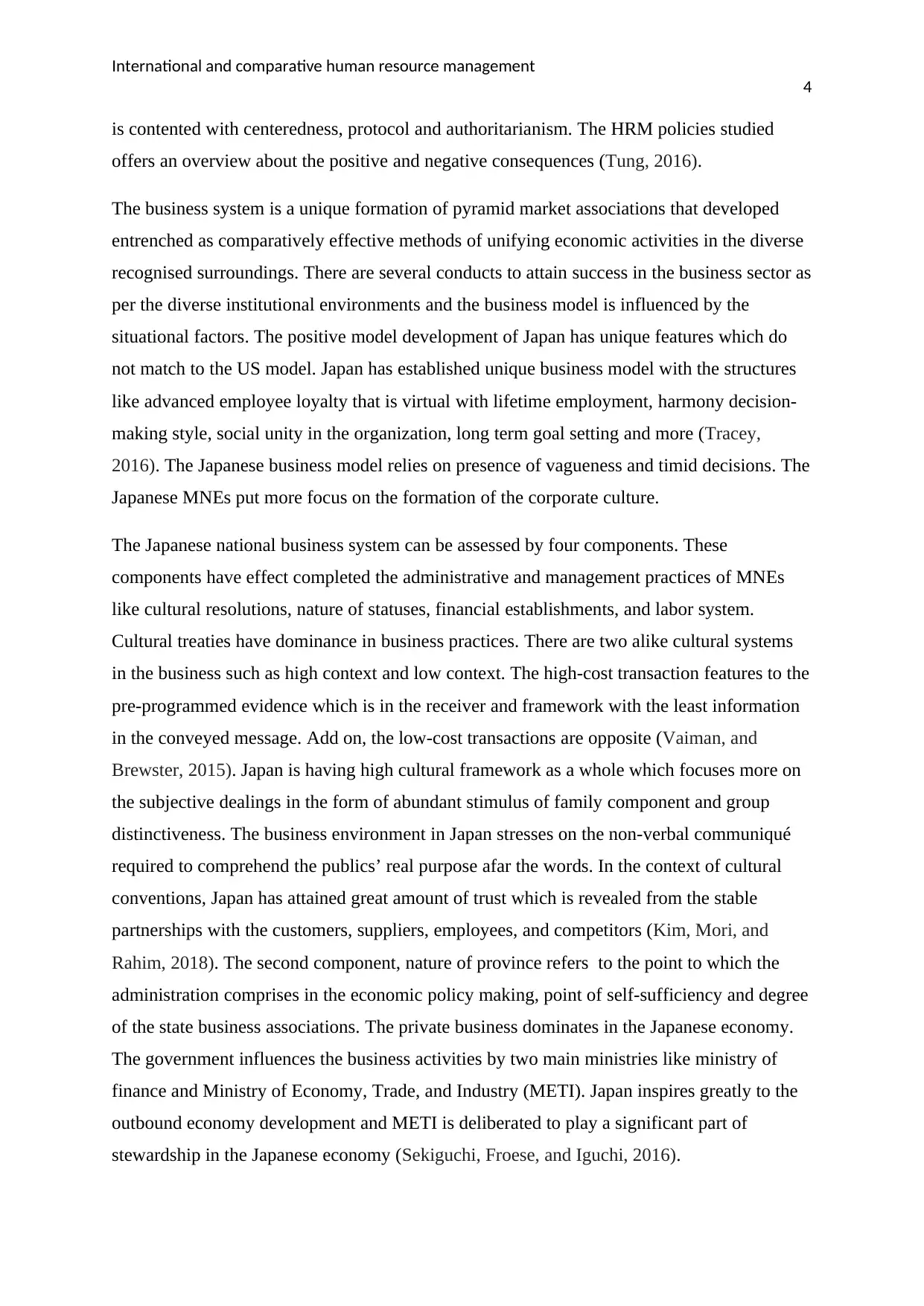
International and comparative human resource management
4
is contented with centeredness, protocol and authoritarianism. The HRM policies studied
offers an overview about the positive and negative consequences (Tung, 2016).
The business system is a unique formation of pyramid market associations that developed
entrenched as comparatively effective methods of unifying economic activities in the diverse
recognised surroundings. There are several conducts to attain success in the business sector as
per the diverse institutional environments and the business model is influenced by the
situational factors. The positive model development of Japan has unique features which do
not match to the US model. Japan has established unique business model with the structures
like advanced employee loyalty that is virtual with lifetime employment, harmony decision-
making style, social unity in the organization, long term goal setting and more (Tracey,
2016). The Japanese business model relies on presence of vagueness and timid decisions. The
Japanese MNEs put more focus on the formation of the corporate culture.
The Japanese national business system can be assessed by four components. These
components have effect completed the administrative and management practices of MNEs
like cultural resolutions, nature of statuses, financial establishments, and labor system.
Cultural treaties have dominance in business practices. There are two alike cultural systems
in the business such as high context and low context. The high-cost transaction features to the
pre-programmed evidence which is in the receiver and framework with the least information
in the conveyed message. Add on, the low-cost transactions are opposite (Vaiman, and
Brewster, 2015). Japan is having high cultural framework as a whole which focuses more on
the subjective dealings in the form of abundant stimulus of family component and group
distinctiveness. The business environment in Japan stresses on the non-verbal communiqué
required to comprehend the publics’ real purpose afar the words. In the context of cultural
conventions, Japan has attained great amount of trust which is revealed from the stable
partnerships with the customers, suppliers, employees, and competitors (Kim, Mori, and
Rahim, 2018). The second component, nature of province refers to the point to which the
administration comprises in the economic policy making, point of self-sufficiency and degree
of the state business associations. The private business dominates in the Japanese economy.
The government influences the business activities by two main ministries like ministry of
finance and Ministry of Economy, Trade, and Industry (METI). Japan inspires greatly to the
outbound economy development and METI is deliberated to play a significant part of
stewardship in the Japanese economy (Sekiguchi, Froese, and Iguchi, 2016).
4
is contented with centeredness, protocol and authoritarianism. The HRM policies studied
offers an overview about the positive and negative consequences (Tung, 2016).
The business system is a unique formation of pyramid market associations that developed
entrenched as comparatively effective methods of unifying economic activities in the diverse
recognised surroundings. There are several conducts to attain success in the business sector as
per the diverse institutional environments and the business model is influenced by the
situational factors. The positive model development of Japan has unique features which do
not match to the US model. Japan has established unique business model with the structures
like advanced employee loyalty that is virtual with lifetime employment, harmony decision-
making style, social unity in the organization, long term goal setting and more (Tracey,
2016). The Japanese business model relies on presence of vagueness and timid decisions. The
Japanese MNEs put more focus on the formation of the corporate culture.
The Japanese national business system can be assessed by four components. These
components have effect completed the administrative and management practices of MNEs
like cultural resolutions, nature of statuses, financial establishments, and labor system.
Cultural treaties have dominance in business practices. There are two alike cultural systems
in the business such as high context and low context. The high-cost transaction features to the
pre-programmed evidence which is in the receiver and framework with the least information
in the conveyed message. Add on, the low-cost transactions are opposite (Vaiman, and
Brewster, 2015). Japan is having high cultural framework as a whole which focuses more on
the subjective dealings in the form of abundant stimulus of family component and group
distinctiveness. The business environment in Japan stresses on the non-verbal communiqué
required to comprehend the publics’ real purpose afar the words. In the context of cultural
conventions, Japan has attained great amount of trust which is revealed from the stable
partnerships with the customers, suppliers, employees, and competitors (Kim, Mori, and
Rahim, 2018). The second component, nature of province refers to the point to which the
administration comprises in the economic policy making, point of self-sufficiency and degree
of the state business associations. The private business dominates in the Japanese economy.
The government influences the business activities by two main ministries like ministry of
finance and Ministry of Economy, Trade, and Industry (METI). Japan inspires greatly to the
outbound economy development and METI is deliberated to play a significant part of
stewardship in the Japanese economy (Sekiguchi, Froese, and Iguchi, 2016).
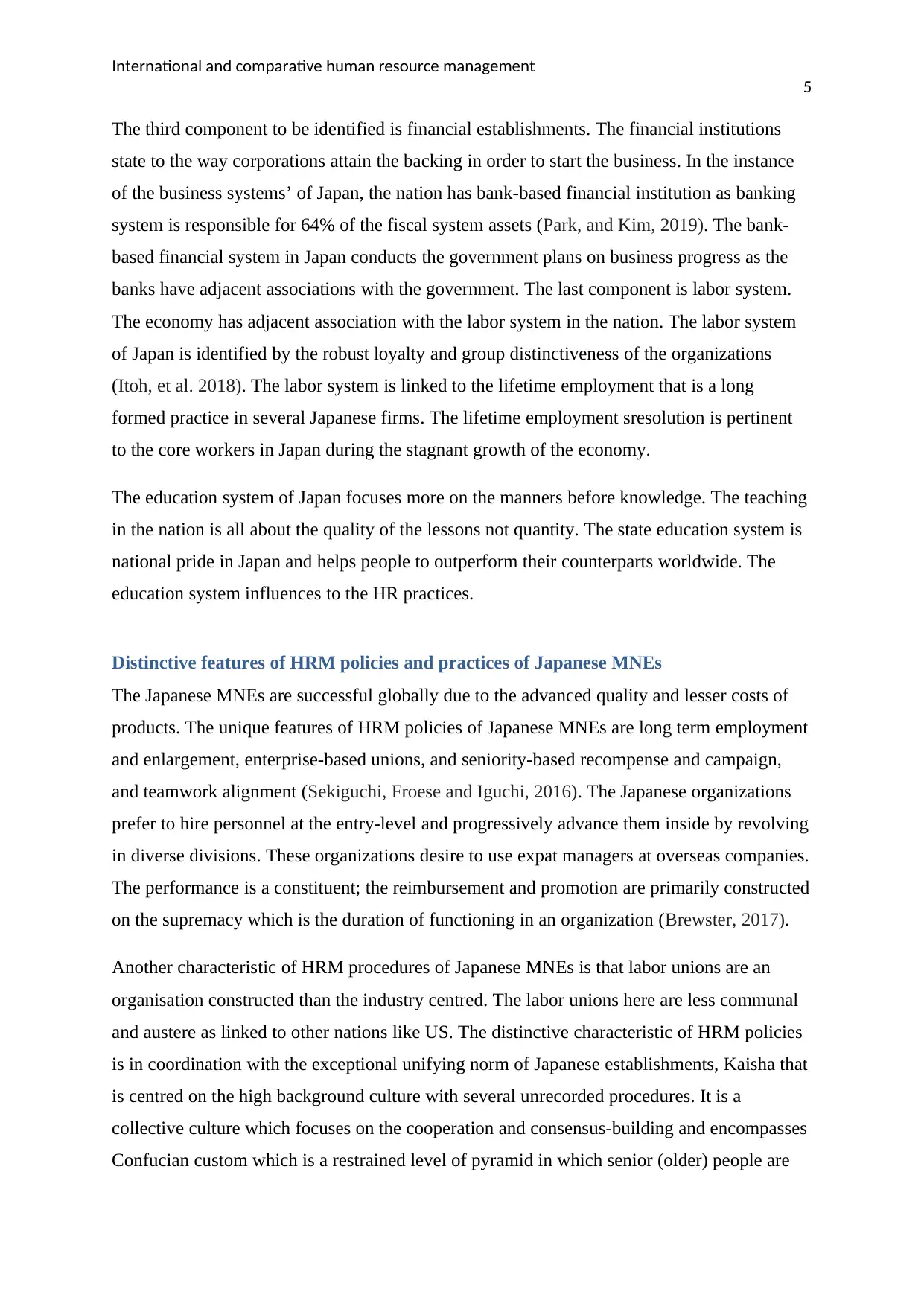
International and comparative human resource management
5
The third component to be identified is financial establishments. The financial institutions
state to the way corporations attain the backing in order to start the business. In the instance
of the business systems’ of Japan, the nation has bank-based financial institution as banking
system is responsible for 64% of the fiscal system assets (Park, and Kim, 2019). The bank-
based financial system in Japan conducts the government plans on business progress as the
banks have adjacent associations with the government. The last component is labor system.
The economy has adjacent association with the labor system in the nation. The labor system
of Japan is identified by the robust loyalty and group distinctiveness of the organizations
(Itoh, et al. 2018). The labor system is linked to the lifetime employment that is a long
formed practice in several Japanese firms. The lifetime employment sresolution is pertinent
to the core workers in Japan during the stagnant growth of the economy.
The education system of Japan focuses more on the manners before knowledge. The teaching
in the nation is all about the quality of the lessons not quantity. The state education system is
national pride in Japan and helps people to outperform their counterparts worldwide. The
education system influences to the HR practices.
Distinctive features of HRM policies and practices of Japanese MNEs
The Japanese MNEs are successful globally due to the advanced quality and lesser costs of
products. The unique features of HRM policies of Japanese MNEs are long term employment
and enlargement, enterprise-based unions, and seniority-based recompense and campaign,
and teamwork alignment (Sekiguchi, Froese and Iguchi, 2016). The Japanese organizations
prefer to hire personnel at the entry-level and progressively advance them inside by revolving
in diverse divisions. These organizations desire to use expat managers at overseas companies.
The performance is a constituent; the reimbursement and promotion are primarily constructed
on the supremacy which is the duration of functioning in an organization (Brewster, 2017).
Another characteristic of HRM procedures of Japanese MNEs is that labor unions are an
organisation constructed than the industry centred. The labor unions here are less communal
and austere as linked to other nations like US. The distinctive characteristic of HRM policies
is in coordination with the exceptional unifying norm of Japanese establishments, Kaisha that
is centred on the high background culture with several unrecorded procedures. It is a
collective culture which focuses on the cooperation and consensus-building and encompasses
Confucian custom which is a restrained level of pyramid in which senior (older) people are
5
The third component to be identified is financial establishments. The financial institutions
state to the way corporations attain the backing in order to start the business. In the instance
of the business systems’ of Japan, the nation has bank-based financial institution as banking
system is responsible for 64% of the fiscal system assets (Park, and Kim, 2019). The bank-
based financial system in Japan conducts the government plans on business progress as the
banks have adjacent associations with the government. The last component is labor system.
The economy has adjacent association with the labor system in the nation. The labor system
of Japan is identified by the robust loyalty and group distinctiveness of the organizations
(Itoh, et al. 2018). The labor system is linked to the lifetime employment that is a long
formed practice in several Japanese firms. The lifetime employment sresolution is pertinent
to the core workers in Japan during the stagnant growth of the economy.
The education system of Japan focuses more on the manners before knowledge. The teaching
in the nation is all about the quality of the lessons not quantity. The state education system is
national pride in Japan and helps people to outperform their counterparts worldwide. The
education system influences to the HR practices.
Distinctive features of HRM policies and practices of Japanese MNEs
The Japanese MNEs are successful globally due to the advanced quality and lesser costs of
products. The unique features of HRM policies of Japanese MNEs are long term employment
and enlargement, enterprise-based unions, and seniority-based recompense and campaign,
and teamwork alignment (Sekiguchi, Froese and Iguchi, 2016). The Japanese organizations
prefer to hire personnel at the entry-level and progressively advance them inside by revolving
in diverse divisions. These organizations desire to use expat managers at overseas companies.
The performance is a constituent; the reimbursement and promotion are primarily constructed
on the supremacy which is the duration of functioning in an organization (Brewster, 2017).
Another characteristic of HRM procedures of Japanese MNEs is that labor unions are an
organisation constructed than the industry centred. The labor unions here are less communal
and austere as linked to other nations like US. The distinctive characteristic of HRM policies
is in coordination with the exceptional unifying norm of Japanese establishments, Kaisha that
is centred on the high background culture with several unrecorded procedures. It is a
collective culture which focuses on the cooperation and consensus-building and encompasses
Confucian custom which is a restrained level of pyramid in which senior (older) people are
⊘ This is a preview!⊘
Do you want full access?
Subscribe today to unlock all pages.

Trusted by 1+ million students worldwide
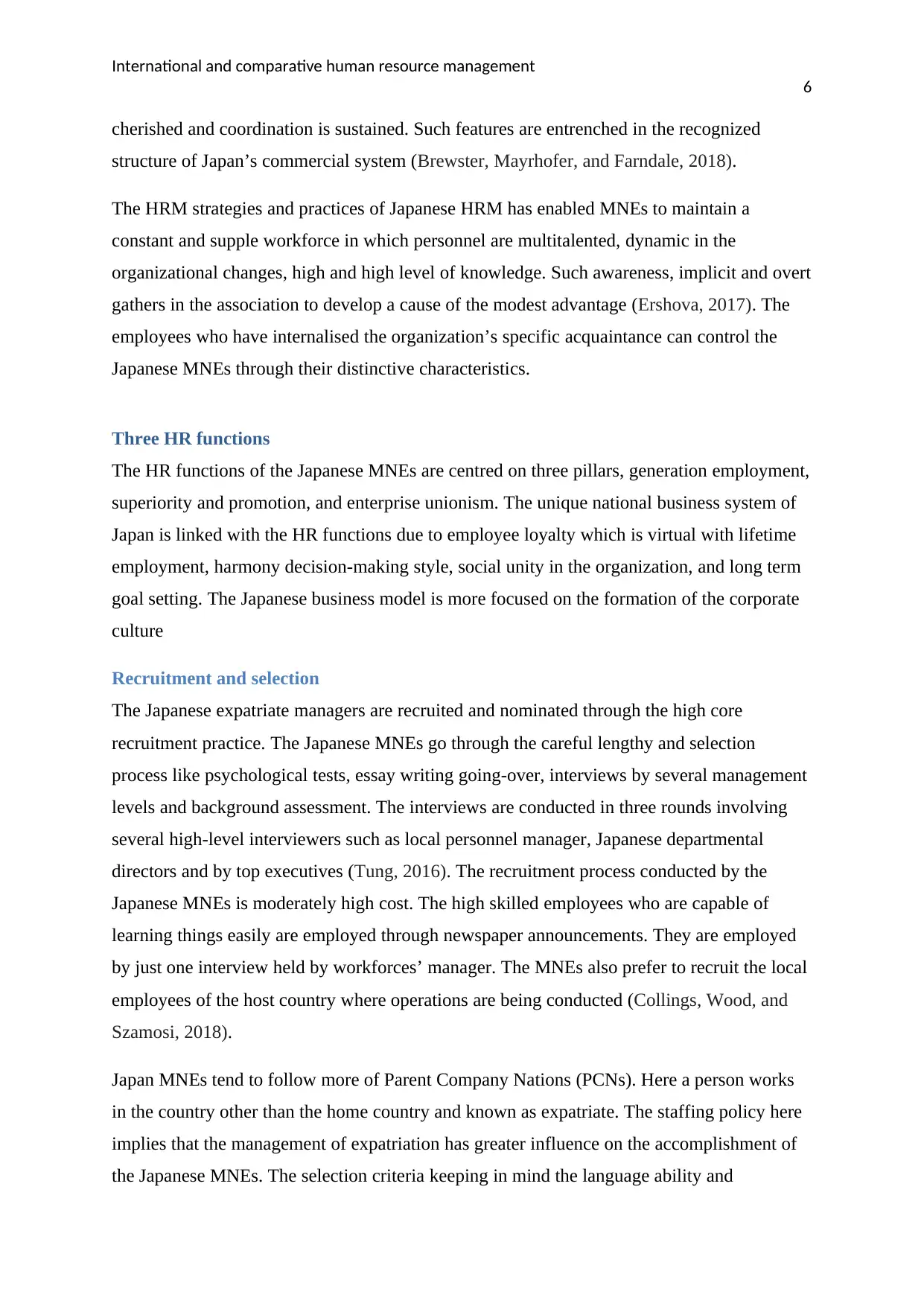
International and comparative human resource management
6
cherished and coordination is sustained. Such features are entrenched in the recognized
structure of Japan’s commercial system (Brewster, Mayrhofer, and Farndale, 2018).
The HRM strategies and practices of Japanese HRM has enabled MNEs to maintain a
constant and supple workforce in which personnel are multitalented, dynamic in the
organizational changes, high and high level of knowledge. Such awareness, implicit and overt
gathers in the association to develop a cause of the modest advantage (Ershova, 2017). The
employees who have internalised the organization’s specific acquaintance can control the
Japanese MNEs through their distinctive characteristics.
Three HR functions
The HR functions of the Japanese MNEs are centred on three pillars, generation employment,
superiority and promotion, and enterprise unionism. The unique national business system of
Japan is linked with the HR functions due to employee loyalty which is virtual with lifetime
employment, harmony decision-making style, social unity in the organization, and long term
goal setting. The Japanese business model is more focused on the formation of the corporate
culture
Recruitment and selection
The Japanese expatriate managers are recruited and nominated through the high core
recruitment practice. The Japanese MNEs go through the careful lengthy and selection
process like psychological tests, essay writing going-over, interviews by several management
levels and background assessment. The interviews are conducted in three rounds involving
several high-level interviewers such as local personnel manager, Japanese departmental
directors and by top executives (Tung, 2016). The recruitment process conducted by the
Japanese MNEs is moderately high cost. The high skilled employees who are capable of
learning things easily are employed through newspaper announcements. They are employed
by just one interview held by workforces’ manager. The MNEs also prefer to recruit the local
employees of the host country where operations are being conducted (Collings, Wood, and
Szamosi, 2018).
Japan MNEs tend to follow more of Parent Company Nations (PCNs). Here a person works
in the country other than the home country and known as expatriate. The staffing policy here
implies that the management of expatriation has greater influence on the accomplishment of
the Japanese MNEs. The selection criteria keeping in mind the language ability and
6
cherished and coordination is sustained. Such features are entrenched in the recognized
structure of Japan’s commercial system (Brewster, Mayrhofer, and Farndale, 2018).
The HRM strategies and practices of Japanese HRM has enabled MNEs to maintain a
constant and supple workforce in which personnel are multitalented, dynamic in the
organizational changes, high and high level of knowledge. Such awareness, implicit and overt
gathers in the association to develop a cause of the modest advantage (Ershova, 2017). The
employees who have internalised the organization’s specific acquaintance can control the
Japanese MNEs through their distinctive characteristics.
Three HR functions
The HR functions of the Japanese MNEs are centred on three pillars, generation employment,
superiority and promotion, and enterprise unionism. The unique national business system of
Japan is linked with the HR functions due to employee loyalty which is virtual with lifetime
employment, harmony decision-making style, social unity in the organization, and long term
goal setting. The Japanese business model is more focused on the formation of the corporate
culture
Recruitment and selection
The Japanese expatriate managers are recruited and nominated through the high core
recruitment practice. The Japanese MNEs go through the careful lengthy and selection
process like psychological tests, essay writing going-over, interviews by several management
levels and background assessment. The interviews are conducted in three rounds involving
several high-level interviewers such as local personnel manager, Japanese departmental
directors and by top executives (Tung, 2016). The recruitment process conducted by the
Japanese MNEs is moderately high cost. The high skilled employees who are capable of
learning things easily are employed through newspaper announcements. They are employed
by just one interview held by workforces’ manager. The MNEs also prefer to recruit the local
employees of the host country where operations are being conducted (Collings, Wood, and
Szamosi, 2018).
Japan MNEs tend to follow more of Parent Company Nations (PCNs). Here a person works
in the country other than the home country and known as expatriate. The staffing policy here
implies that the management of expatriation has greater influence on the accomplishment of
the Japanese MNEs. The selection criteria keeping in mind the language ability and
Paraphrase This Document
Need a fresh take? Get an instant paraphrase of this document with our AI Paraphraser
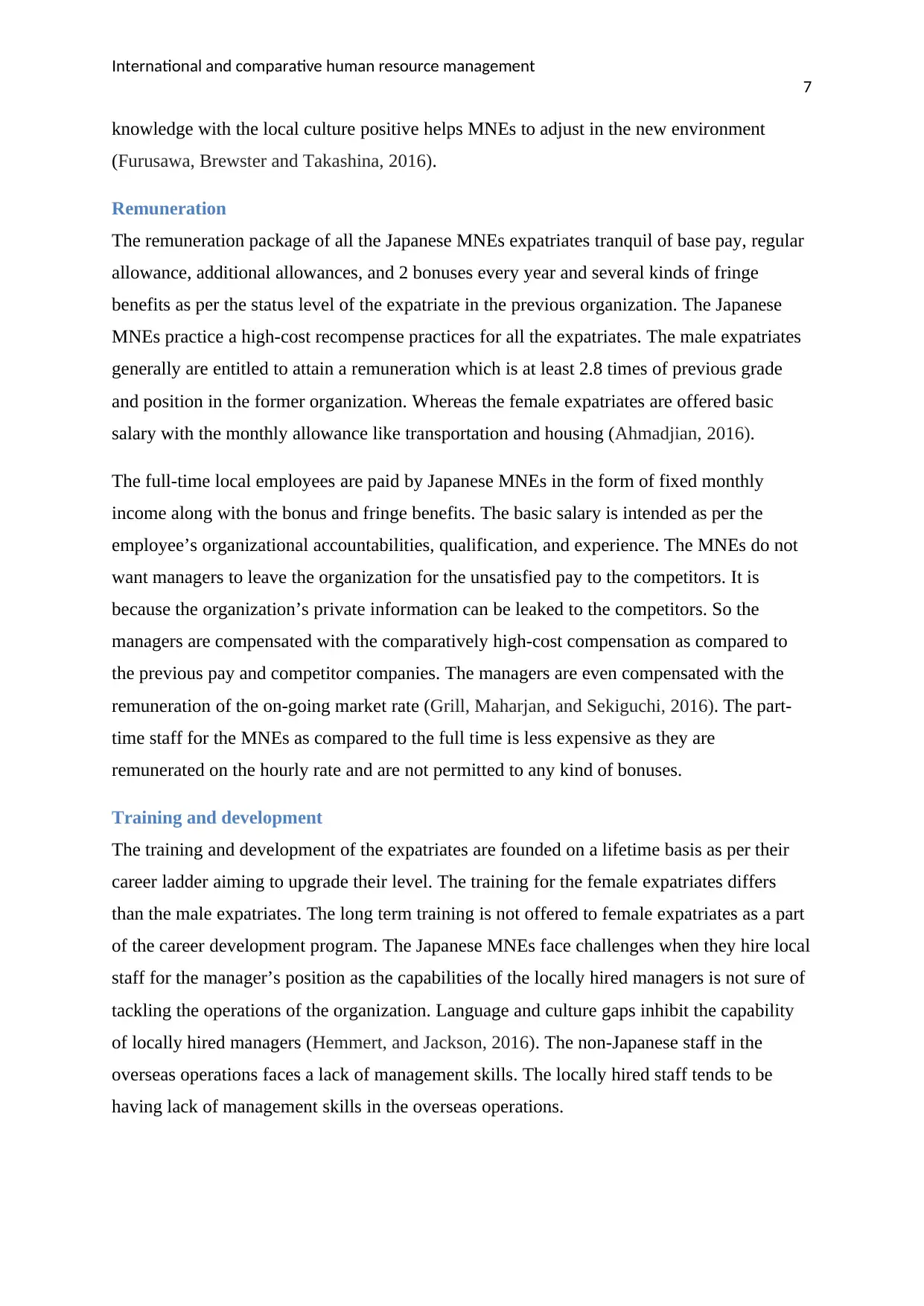
International and comparative human resource management
7
knowledge with the local culture positive helps MNEs to adjust in the new environment
(Furusawa, Brewster and Takashina, 2016).
Remuneration
The remuneration package of all the Japanese MNEs expatriates tranquil of base pay, regular
allowance, additional allowances, and 2 bonuses every year and several kinds of fringe
benefits as per the status level of the expatriate in the previous organization. The Japanese
MNEs practice a high-cost recompense practices for all the expatriates. The male expatriates
generally are entitled to attain a remuneration which is at least 2.8 times of previous grade
and position in the former organization. Whereas the female expatriates are offered basic
salary with the monthly allowance like transportation and housing (Ahmadjian, 2016).
The full-time local employees are paid by Japanese MNEs in the form of fixed monthly
income along with the bonus and fringe benefits. The basic salary is intended as per the
employee’s organizational accountabilities, qualification, and experience. The MNEs do not
want managers to leave the organization for the unsatisfied pay to the competitors. It is
because the organization’s private information can be leaked to the competitors. So the
managers are compensated with the comparatively high-cost compensation as compared to
the previous pay and competitor companies. The managers are even compensated with the
remuneration of the on-going market rate (Grill, Maharjan, and Sekiguchi, 2016). The part-
time staff for the MNEs as compared to the full time is less expensive as they are
remunerated on the hourly rate and are not permitted to any kind of bonuses.
Training and development
The training and development of the expatriates are founded on a lifetime basis as per their
career ladder aiming to upgrade their level. The training for the female expatriates differs
than the male expatriates. The long term training is not offered to female expatriates as a part
of the career development program. The Japanese MNEs face challenges when they hire local
staff for the manager’s position as the capabilities of the locally hired managers is not sure of
tackling the operations of the organization. Language and culture gaps inhibit the capability
of locally hired managers (Hemmert, and Jackson, 2016). The non-Japanese staff in the
overseas operations faces a lack of management skills. The locally hired staff tends to be
having lack of management skills in the overseas operations.
7
knowledge with the local culture positive helps MNEs to adjust in the new environment
(Furusawa, Brewster and Takashina, 2016).
Remuneration
The remuneration package of all the Japanese MNEs expatriates tranquil of base pay, regular
allowance, additional allowances, and 2 bonuses every year and several kinds of fringe
benefits as per the status level of the expatriate in the previous organization. The Japanese
MNEs practice a high-cost recompense practices for all the expatriates. The male expatriates
generally are entitled to attain a remuneration which is at least 2.8 times of previous grade
and position in the former organization. Whereas the female expatriates are offered basic
salary with the monthly allowance like transportation and housing (Ahmadjian, 2016).
The full-time local employees are paid by Japanese MNEs in the form of fixed monthly
income along with the bonus and fringe benefits. The basic salary is intended as per the
employee’s organizational accountabilities, qualification, and experience. The MNEs do not
want managers to leave the organization for the unsatisfied pay to the competitors. It is
because the organization’s private information can be leaked to the competitors. So the
managers are compensated with the comparatively high-cost compensation as compared to
the previous pay and competitor companies. The managers are even compensated with the
remuneration of the on-going market rate (Grill, Maharjan, and Sekiguchi, 2016). The part-
time staff for the MNEs as compared to the full time is less expensive as they are
remunerated on the hourly rate and are not permitted to any kind of bonuses.
Training and development
The training and development of the expatriates are founded on a lifetime basis as per their
career ladder aiming to upgrade their level. The training for the female expatriates differs
than the male expatriates. The long term training is not offered to female expatriates as a part
of the career development program. The Japanese MNEs face challenges when they hire local
staff for the manager’s position as the capabilities of the locally hired managers is not sure of
tackling the operations of the organization. Language and culture gaps inhibit the capability
of locally hired managers (Hemmert, and Jackson, 2016). The non-Japanese staff in the
overseas operations faces a lack of management skills. The locally hired staff tends to be
having lack of management skills in the overseas operations.
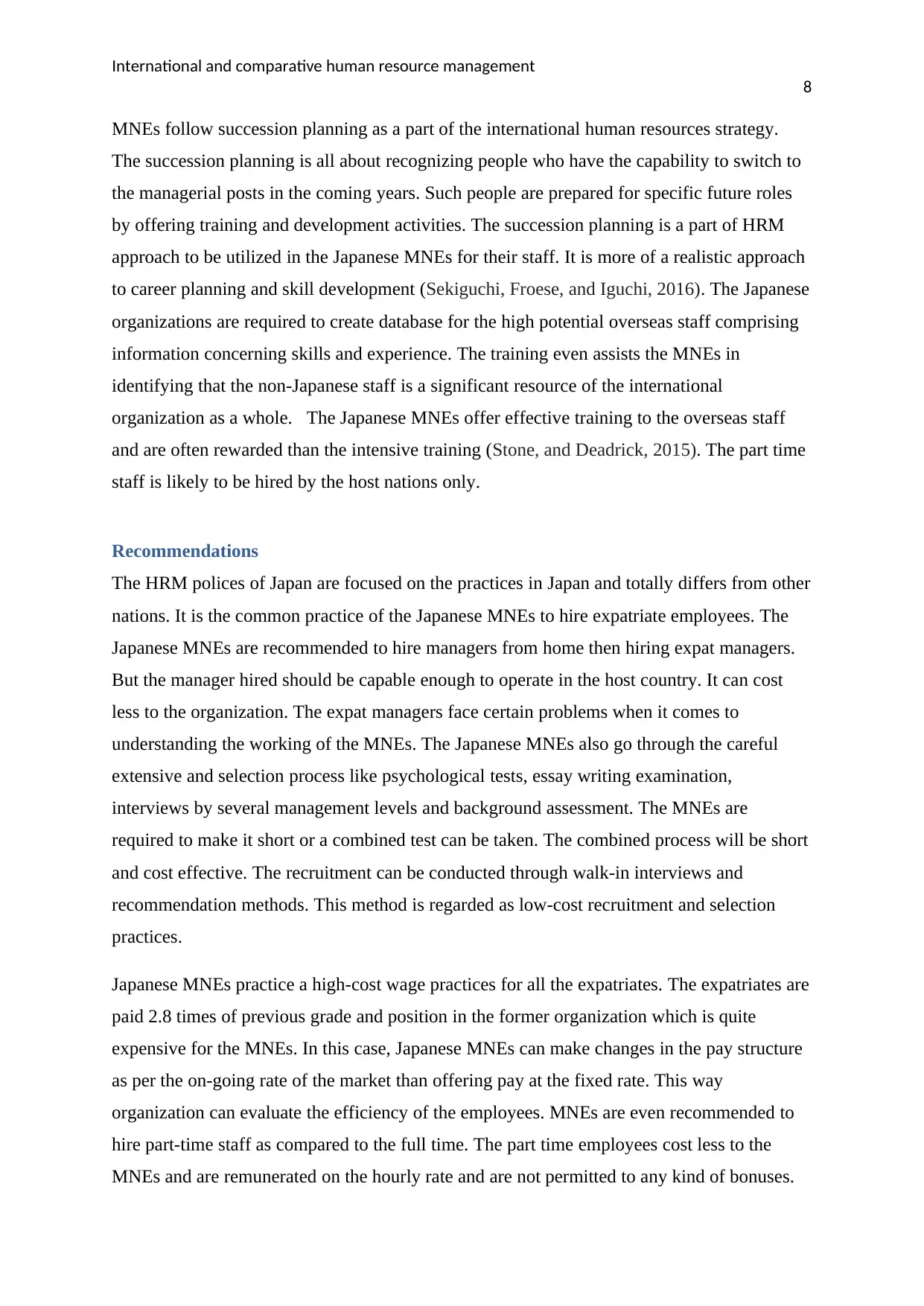
International and comparative human resource management
8
MNEs follow succession planning as a part of the international human resources strategy.
The succession planning is all about recognizing people who have the capability to switch to
the managerial posts in the coming years. Such people are prepared for specific future roles
by offering training and development activities. The succession planning is a part of HRM
approach to be utilized in the Japanese MNEs for their staff. It is more of a realistic approach
to career planning and skill development (Sekiguchi, Froese, and Iguchi, 2016). The Japanese
organizations are required to create database for the high potential overseas staff comprising
information concerning skills and experience. The training even assists the MNEs in
identifying that the non-Japanese staff is a significant resource of the international
organization as a whole. The Japanese MNEs offer effective training to the overseas staff
and are often rewarded than the intensive training (Stone, and Deadrick, 2015). The part time
staff is likely to be hired by the host nations only.
Recommendations
The HRM polices of Japan are focused on the practices in Japan and totally differs from other
nations. It is the common practice of the Japanese MNEs to hire expatriate employees. The
Japanese MNEs are recommended to hire managers from home then hiring expat managers.
But the manager hired should be capable enough to operate in the host country. It can cost
less to the organization. The expat managers face certain problems when it comes to
understanding the working of the MNEs. The Japanese MNEs also go through the careful
extensive and selection process like psychological tests, essay writing examination,
interviews by several management levels and background assessment. The MNEs are
required to make it short or a combined test can be taken. The combined process will be short
and cost effective. The recruitment can be conducted through walk-in interviews and
recommendation methods. This method is regarded as low-cost recruitment and selection
practices.
Japanese MNEs practice a high-cost wage practices for all the expatriates. The expatriates are
paid 2.8 times of previous grade and position in the former organization which is quite
expensive for the MNEs. In this case, Japanese MNEs can make changes in the pay structure
as per the on-going rate of the market than offering pay at the fixed rate. This way
organization can evaluate the efficiency of the employees. MNEs are even recommended to
hire part-time staff as compared to the full time. The part time employees cost less to the
MNEs and are remunerated on the hourly rate and are not permitted to any kind of bonuses.
8
MNEs follow succession planning as a part of the international human resources strategy.
The succession planning is all about recognizing people who have the capability to switch to
the managerial posts in the coming years. Such people are prepared for specific future roles
by offering training and development activities. The succession planning is a part of HRM
approach to be utilized in the Japanese MNEs for their staff. It is more of a realistic approach
to career planning and skill development (Sekiguchi, Froese, and Iguchi, 2016). The Japanese
organizations are required to create database for the high potential overseas staff comprising
information concerning skills and experience. The training even assists the MNEs in
identifying that the non-Japanese staff is a significant resource of the international
organization as a whole. The Japanese MNEs offer effective training to the overseas staff
and are often rewarded than the intensive training (Stone, and Deadrick, 2015). The part time
staff is likely to be hired by the host nations only.
Recommendations
The HRM polices of Japan are focused on the practices in Japan and totally differs from other
nations. It is the common practice of the Japanese MNEs to hire expatriate employees. The
Japanese MNEs are recommended to hire managers from home then hiring expat managers.
But the manager hired should be capable enough to operate in the host country. It can cost
less to the organization. The expat managers face certain problems when it comes to
understanding the working of the MNEs. The Japanese MNEs also go through the careful
extensive and selection process like psychological tests, essay writing examination,
interviews by several management levels and background assessment. The MNEs are
required to make it short or a combined test can be taken. The combined process will be short
and cost effective. The recruitment can be conducted through walk-in interviews and
recommendation methods. This method is regarded as low-cost recruitment and selection
practices.
Japanese MNEs practice a high-cost wage practices for all the expatriates. The expatriates are
paid 2.8 times of previous grade and position in the former organization which is quite
expensive for the MNEs. In this case, Japanese MNEs can make changes in the pay structure
as per the on-going rate of the market than offering pay at the fixed rate. This way
organization can evaluate the efficiency of the employees. MNEs are even recommended to
hire part-time staff as compared to the full time. The part time employees cost less to the
MNEs and are remunerated on the hourly rate and are not permitted to any kind of bonuses.
⊘ This is a preview!⊘
Do you want full access?
Subscribe today to unlock all pages.

Trusted by 1+ million students worldwide
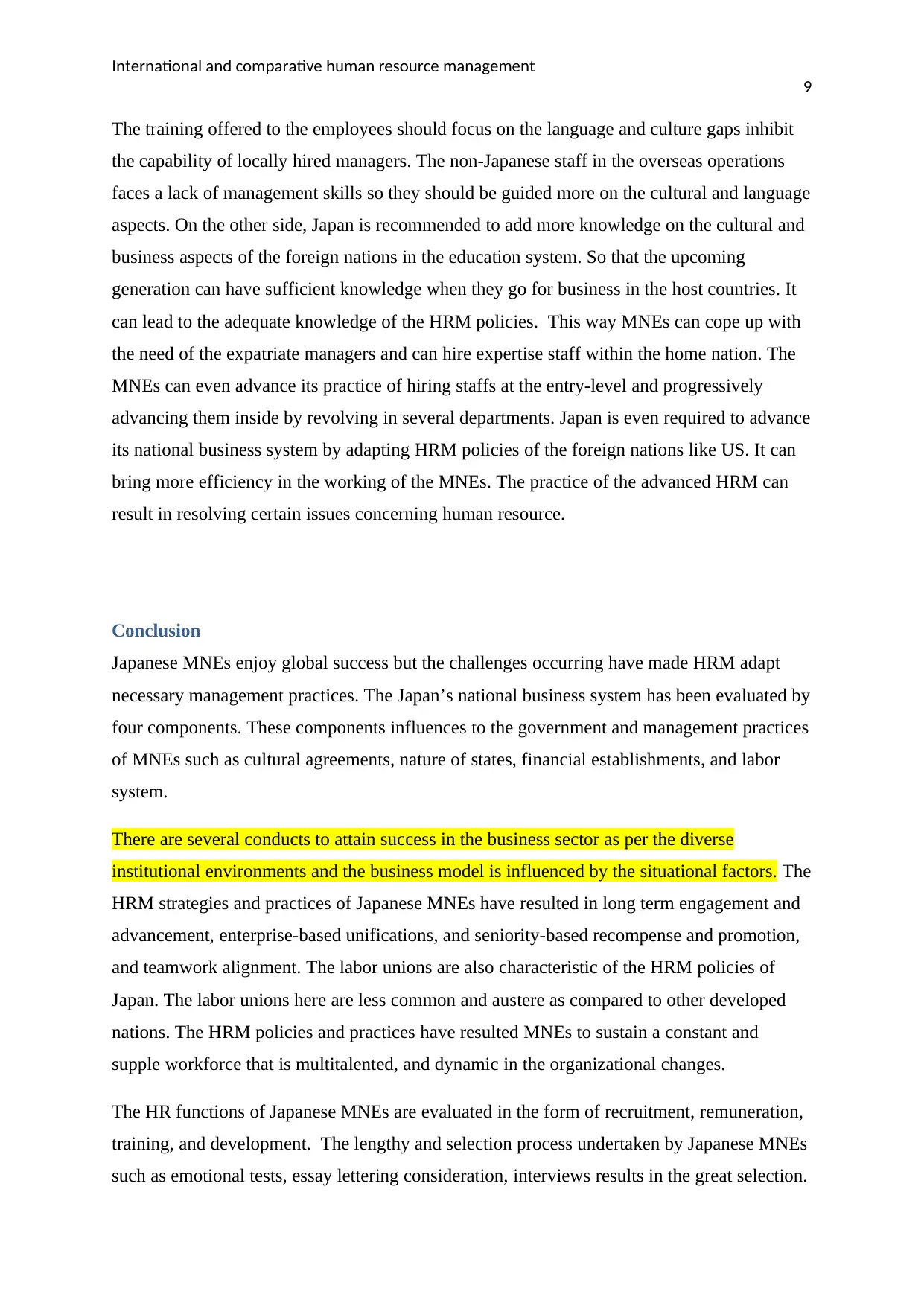
International and comparative human resource management
9
The training offered to the employees should focus on the language and culture gaps inhibit
the capability of locally hired managers. The non-Japanese staff in the overseas operations
faces a lack of management skills so they should be guided more on the cultural and language
aspects. On the other side, Japan is recommended to add more knowledge on the cultural and
business aspects of the foreign nations in the education system. So that the upcoming
generation can have sufficient knowledge when they go for business in the host countries. It
can lead to the adequate knowledge of the HRM policies. This way MNEs can cope up with
the need of the expatriate managers and can hire expertise staff within the home nation. The
MNEs can even advance its practice of hiring staffs at the entry-level and progressively
advancing them inside by revolving in several departments. Japan is even required to advance
its national business system by adapting HRM policies of the foreign nations like US. It can
bring more efficiency in the working of the MNEs. The practice of the advanced HRM can
result in resolving certain issues concerning human resource.
Conclusion
Japanese MNEs enjoy global success but the challenges occurring have made HRM adapt
necessary management practices. The Japan’s national business system has been evaluated by
four components. These components influences to the government and management practices
of MNEs such as cultural agreements, nature of states, financial establishments, and labor
system.
There are several conducts to attain success in the business sector as per the diverse
institutional environments and the business model is influenced by the situational factors. The
HRM strategies and practices of Japanese MNEs have resulted in long term engagement and
advancement, enterprise-based unifications, and seniority-based recompense and promotion,
and teamwork alignment. The labor unions are also characteristic of the HRM policies of
Japan. The labor unions here are less common and austere as compared to other developed
nations. The HRM policies and practices have resulted MNEs to sustain a constant and
supple workforce that is multitalented, and dynamic in the organizational changes.
The HR functions of Japanese MNEs are evaluated in the form of recruitment, remuneration,
training, and development. The lengthy and selection process undertaken by Japanese MNEs
such as emotional tests, essay lettering consideration, interviews results in the great selection.
9
The training offered to the employees should focus on the language and culture gaps inhibit
the capability of locally hired managers. The non-Japanese staff in the overseas operations
faces a lack of management skills so they should be guided more on the cultural and language
aspects. On the other side, Japan is recommended to add more knowledge on the cultural and
business aspects of the foreign nations in the education system. So that the upcoming
generation can have sufficient knowledge when they go for business in the host countries. It
can lead to the adequate knowledge of the HRM policies. This way MNEs can cope up with
the need of the expatriate managers and can hire expertise staff within the home nation. The
MNEs can even advance its practice of hiring staffs at the entry-level and progressively
advancing them inside by revolving in several departments. Japan is even required to advance
its national business system by adapting HRM policies of the foreign nations like US. It can
bring more efficiency in the working of the MNEs. The practice of the advanced HRM can
result in resolving certain issues concerning human resource.
Conclusion
Japanese MNEs enjoy global success but the challenges occurring have made HRM adapt
necessary management practices. The Japan’s national business system has been evaluated by
four components. These components influences to the government and management practices
of MNEs such as cultural agreements, nature of states, financial establishments, and labor
system.
There are several conducts to attain success in the business sector as per the diverse
institutional environments and the business model is influenced by the situational factors. The
HRM strategies and practices of Japanese MNEs have resulted in long term engagement and
advancement, enterprise-based unifications, and seniority-based recompense and promotion,
and teamwork alignment. The labor unions are also characteristic of the HRM policies of
Japan. The labor unions here are less common and austere as compared to other developed
nations. The HRM policies and practices have resulted MNEs to sustain a constant and
supple workforce that is multitalented, and dynamic in the organizational changes.
The HR functions of Japanese MNEs are evaluated in the form of recruitment, remuneration,
training, and development. The lengthy and selection process undertaken by Japanese MNEs
such as emotional tests, essay lettering consideration, interviews results in the great selection.
Paraphrase This Document
Need a fresh take? Get an instant paraphrase of this document with our AI Paraphraser
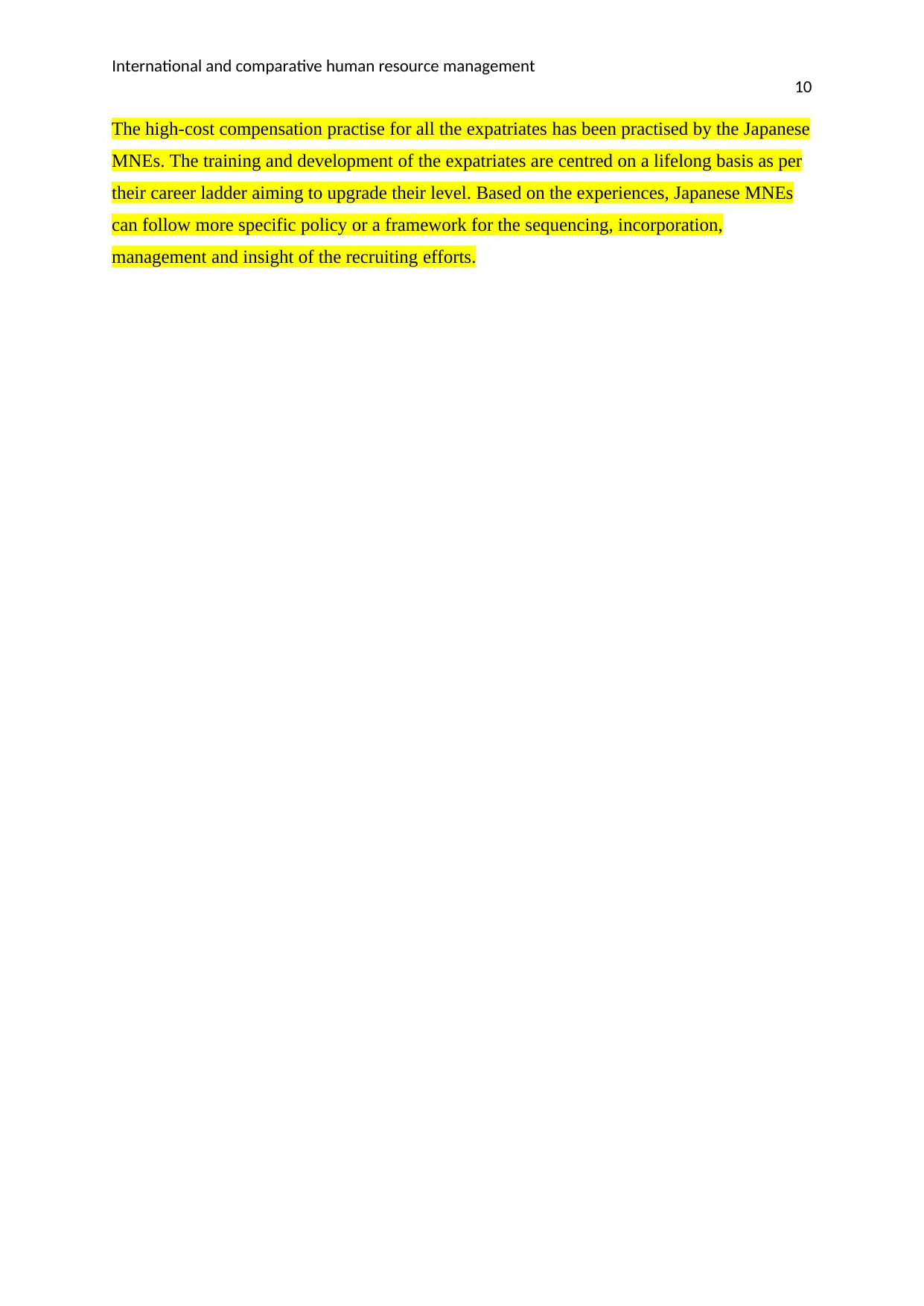
International and comparative human resource management
10
The high-cost compensation practise for all the expatriates has been practised by the Japanese
MNEs. The training and development of the expatriates are centred on a lifelong basis as per
their career ladder aiming to upgrade their level. Based on the experiences, Japanese MNEs
can follow more specific policy or a framework for the sequencing, incorporation,
management and insight of the recruiting efforts.
10
The high-cost compensation practise for all the expatriates has been practised by the Japanese
MNEs. The training and development of the expatriates are centred on a lifelong basis as per
their career ladder aiming to upgrade their level. Based on the experiences, Japanese MNEs
can follow more specific policy or a framework for the sequencing, incorporation,
management and insight of the recruiting efforts.
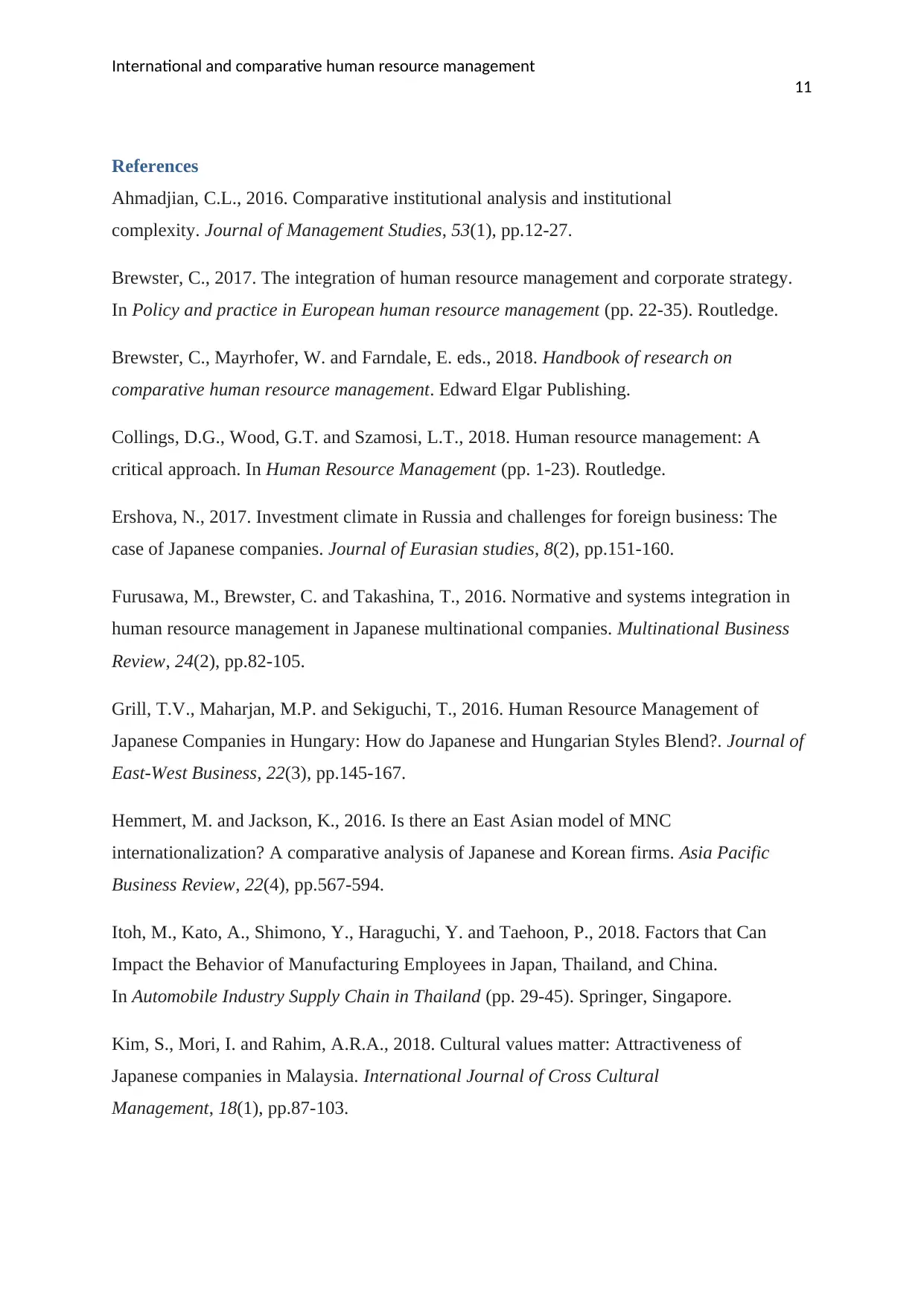
International and comparative human resource management
11
References
Ahmadjian, C.L., 2016. Comparative institutional analysis and institutional
complexity. Journal of Management Studies, 53(1), pp.12-27.
Brewster, C., 2017. The integration of human resource management and corporate strategy.
In Policy and practice in European human resource management (pp. 22-35). Routledge.
Brewster, C., Mayrhofer, W. and Farndale, E. eds., 2018. Handbook of research on
comparative human resource management. Edward Elgar Publishing.
Collings, D.G., Wood, G.T. and Szamosi, L.T., 2018. Human resource management: A
critical approach. In Human Resource Management (pp. 1-23). Routledge.
Ershova, N., 2017. Investment climate in Russia and challenges for foreign business: The
case of Japanese companies. Journal of Eurasian studies, 8(2), pp.151-160.
Furusawa, M., Brewster, C. and Takashina, T., 2016. Normative and systems integration in
human resource management in Japanese multinational companies. Multinational Business
Review, 24(2), pp.82-105.
Grill, T.V., Maharjan, M.P. and Sekiguchi, T., 2016. Human Resource Management of
Japanese Companies in Hungary: How do Japanese and Hungarian Styles Blend?. Journal of
East-West Business, 22(3), pp.145-167.
Hemmert, M. and Jackson, K., 2016. Is there an East Asian model of MNC
internationalization? A comparative analysis of Japanese and Korean firms. Asia Pacific
Business Review, 22(4), pp.567-594.
Itoh, M., Kato, A., Shimono, Y., Haraguchi, Y. and Taehoon, P., 2018. Factors that Can
Impact the Behavior of Manufacturing Employees in Japan, Thailand, and China.
In Automobile Industry Supply Chain in Thailand (pp. 29-45). Springer, Singapore.
Kim, S., Mori, I. and Rahim, A.R.A., 2018. Cultural values matter: Attractiveness of
Japanese companies in Malaysia. International Journal of Cross Cultural
Management, 18(1), pp.87-103.
11
References
Ahmadjian, C.L., 2016. Comparative institutional analysis and institutional
complexity. Journal of Management Studies, 53(1), pp.12-27.
Brewster, C., 2017. The integration of human resource management and corporate strategy.
In Policy and practice in European human resource management (pp. 22-35). Routledge.
Brewster, C., Mayrhofer, W. and Farndale, E. eds., 2018. Handbook of research on
comparative human resource management. Edward Elgar Publishing.
Collings, D.G., Wood, G.T. and Szamosi, L.T., 2018. Human resource management: A
critical approach. In Human Resource Management (pp. 1-23). Routledge.
Ershova, N., 2017. Investment climate in Russia and challenges for foreign business: The
case of Japanese companies. Journal of Eurasian studies, 8(2), pp.151-160.
Furusawa, M., Brewster, C. and Takashina, T., 2016. Normative and systems integration in
human resource management in Japanese multinational companies. Multinational Business
Review, 24(2), pp.82-105.
Grill, T.V., Maharjan, M.P. and Sekiguchi, T., 2016. Human Resource Management of
Japanese Companies in Hungary: How do Japanese and Hungarian Styles Blend?. Journal of
East-West Business, 22(3), pp.145-167.
Hemmert, M. and Jackson, K., 2016. Is there an East Asian model of MNC
internationalization? A comparative analysis of Japanese and Korean firms. Asia Pacific
Business Review, 22(4), pp.567-594.
Itoh, M., Kato, A., Shimono, Y., Haraguchi, Y. and Taehoon, P., 2018. Factors that Can
Impact the Behavior of Manufacturing Employees in Japan, Thailand, and China.
In Automobile Industry Supply Chain in Thailand (pp. 29-45). Springer, Singapore.
Kim, S., Mori, I. and Rahim, A.R.A., 2018. Cultural values matter: Attractiveness of
Japanese companies in Malaysia. International Journal of Cross Cultural
Management, 18(1), pp.87-103.
⊘ This is a preview!⊘
Do you want full access?
Subscribe today to unlock all pages.

Trusted by 1+ million students worldwide
1 out of 13
Related Documents
Your All-in-One AI-Powered Toolkit for Academic Success.
+13062052269
info@desklib.com
Available 24*7 on WhatsApp / Email
![[object Object]](/_next/static/media/star-bottom.7253800d.svg)
Unlock your academic potential
Copyright © 2020–2025 A2Z Services. All Rights Reserved. Developed and managed by ZUCOL.





